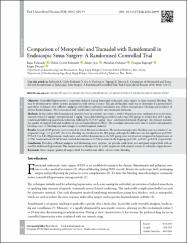Comparison of metoprolol and tramadol with remifentanil in endoscopic sinus surgery: a randomised controlled trial

Göster/
Erişim
info:eu-repo/semantics/openAccessTarih
2018Yazar
Erdivanlı, BaşarErdivanlı, Özlem Çelebi
Şen, Ahmet
Özdemir, Abdullah
Tuğcugil, Ersagun
Dursun, Engin
Üst veri
Tüm öğe kaydını gösterKünye
Erdivanlı, B., Erdivanlı, ÖÇ., Şen, A., Özdemir, A., Tuğcugil, E., Dursun, E. (2018). Comparison of metoprolol and tramadol with remifentanil in endoscopic sinus surgery: a randomised controlled trial. Turkish Journal of Anaesthesiology and Reanimation, 46(6), 424-433.Özet
Objective: Controlled hypotension is commonly induced during functional endoscopic sinus surgery to limit mucosal bleeding. This may be detrimental to elderly patients and patients with arterial stenosis. The aim of this pilot study was to determine if a normotensive anaesthetic technique with sufficient analgesia and without profound vasodilation may reduce intraoperative bleeding and incidence of adverse haemodynamic effects associated with vasodilation and variable rate continuous infusions. Methods: In this double-blind randomised controlled trial in a tertiary care centre, a total of 88 patients were randomised to receive intravenously either 0.1 mg kg?1 metoprolol and 1 mg kg?1 tramadol following anaesthesia induction (MT group) or a bolus dose of 0.5 ?g kg?1 remifentanil following anaesthesia induction, followed by 0.25-0.5 ?g kg?1 min?1 remifentanil infusion (R group). The primary outcome was quality of surgical field and incidence of adverse haemodynamic effects. The secondary outcomes were time to achieve intraoperative bleeding score <3, bleeding rate and changes in cerebral regional oximetry. Results: A total of 105 patients were recruited, in which 88 were randomised. The median intraoperative bleeding score was similar (1, interquartile range: 1-1, p=0.69). The mean bleeding rate was lower in the MT group, although the difference was not significant (p=0.052, 95% CI 0 to 8.8). Hypotension, bradycardia and cerebral desaturation in the MT group were not observed compared to hypotension in 3 (7%), bradycardia in 18 (41%) and cerebral desaturation in 2 (5%) patients in the R group (p=0.241, p<0.001, p=0.474, respectively). Conclusion: Providing sufficient analgesia and eliminating stress response can provide stable heart rate and good surgical field with no need for additional hypotension. This normotensive technique may be useful in patients with stenotic arteries or ischaemic organ diseases.
Kaynak
Turkish Journal of Anaesthesiology and ReanimationCilt
46Sayı
6Bağlantı
https://doi.org/10.5152/TJAR.2018.28999https://app.trdizin.gov.tr/makale/TXpBNE1USTNOdz09
https://hdl.handle.net/11436/5734

















